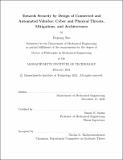Towards security by design of connected and automated vehicles : cyber and physical threats, mitigations, and architectures
Author(s)
Suo, Dajiang.
Download1252630635-MIT.pdf (7.788Mb)
Other Contributors
Massachusetts Institute of Technology. Department of Mechanical Engineering.
Advisor
Sanjay E. Sarma.
Terms of use
Metadata
Show full item recordAbstract
Security, safety and privacy converge when it comes to the design of cyber-physical systems (CPS) such as connected and automated vehicles (CAVs). This trend can be attributed to the increased level of connectivity and automation and the new potential of insider attacks caused by changes in vehicle ownership. For example, A CAV whose on-board sensors, such as Light detection and ranging (LIDAR) and camera, are under spoofing attacks or subject to variations in environmental conditions (e.g., light, weather) may conduct risky maneuvers. Additionally, a CAV that can communicate with nearby vehicles, cloud servers, and roadside infrastructure can be turned into a "cyber-weapon" by adversaries to compromise transportation services or customer privacy. Designing mitigation solutions is a challenging task for Original equipment manufacturers who need to prioritize among safety, security, and privacy, and deal with ever-changing attack surfaces and the power of attackers. This thesis proposes a security by design framework for identifying and mitigating cyber and physical threats on CAVs. A structured security engineering process for threat identification is first presented, which provides guidance to designing defensive mechanisms such that any compromise in design goals is traceable to a specific cyber or physical attack. After prioritizing among different identified threats, this thesis focuses on solutions to mitigate two types of threats: Physical threats on perception tasks with optical sensors and cyber threats on traffic event forgery in Vehicle-to-Infrastructure (V2I) communication. Second, to mitigate physical threats to on-board optical sensors caused by environmental hazards, this thesis develops a object-recognition method based on light polarization. The proposed approach can provide multimodal data providing clues about the surface of objects, which complements the depth and RGB information from existing optical sensors. A proof-of-concept platform built in a laboratory benchtop verifies and evaluates the proposed concept. Third, a secure V2I communication protocol titled "Proof-of-Travel" (POT) is developed to verify the authenticity of V2I messages. This novel approach utilizes and combines the physical laws of vehicle movement with cryptography mechanisms used for ensuring the security of distributed networks. By developing and demonstrating these two proof-of-concept mitigation solutions, this thesis illustrates that security and safety goals for cyber-physical systems can be achieved more cost-effectively by following the security by design framework.
Description
Thesis: Ph. D., Massachusetts Institute of Technology, Department of Mechanical Engineering, February, 2021 Cataloged from the official PDF of thesis. Includes bibliographical references (pages 103-115).
Date issued
2021Department
Massachusetts Institute of Technology. Department of Mechanical EngineeringPublisher
Massachusetts Institute of Technology
Keywords
Mechanical Engineering.